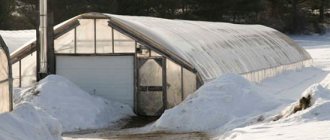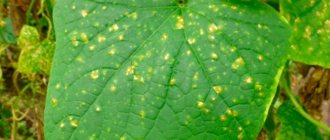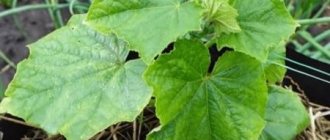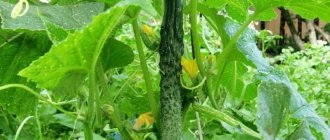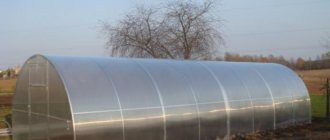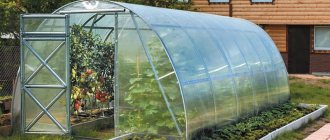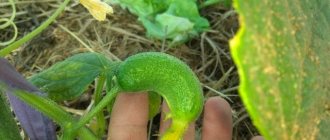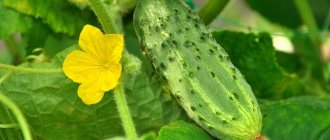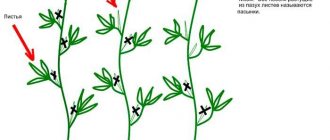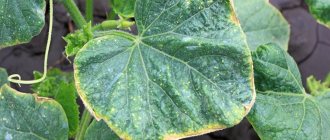Description of the variety
The variety is early ripening, parthenocarpic (does not require insects for pollination), high-yielding. The stem of an adult bush during the fruiting period resembles a New Year's garland, densely dotted with greenery. All this, plus tolerance to cold weather, determined the name of the cucumber.
The bush is powerful, the internode is shortened, the leaves are medium in size. Zelentsy are small, from 5–8 cm, finely tuberculate, covered with non-thorny spines and white fluff. The color of the skin is dark green at the base, gradually becoming lighter towards the top of the fruit. It has a pleasant taste, without bitterness, the flesh is crisp and juicy, with a small seed chamber. The fruits do not outgrow.
In a node, in place of one flower, three or more ovaries are formed. The yield of the variety, with proper shaping of the bush, reaches up to 400 fruits per bush or up to 40 kg per 1 sq. m.
The first green plants appear 40–45 days after germination. When planted in late April or early May, cucumbers are harvested in mid-June.
The variety is excellent for cultivation throughout Russia, Ukraine, Moldova and Belarus. The main condition: not too cold weather, moderate climate, short drought, abundant watering and fertilizing.
Table: advantages and disadvantages of the Siberian Garland F1 variety
| Advantages | Flaws |
| High yield | High price |
| Early ripening and self-pollinating | When pollinated by insects, fruits are deformed |
| Long-term fruiting | Correct shaping of a bush into one stem |
| Doesn't outgrow | It is necessary to remove cucumbers once a day, otherwise fruiting will be inhibited. |
| High yield | |
| Great taste and versatility | |
| Adapts well to weather conditions | |
| Disease resistance |
Photo gallery: cucumber Siberian Garland F1
Cucumber Siberian garland F1 on a trellis
Cucumber Siberian garland F1 in a greenhouse
The first ovaries of the Siberian Garland cucumber
Packaging of seeds Siberian Garland F1
Video: Growing cucumbers of the Siberian Garland F1 variety
Where did bouquet gherkins come from?
In recent years, gardeners have been particularly interested in high-yielding bunch gherkins or, as they are also called, bouquet gherkins - small-fruited cucumbers with excellent culinary qualities. The creation of new hybrids of such vegetables is actively pursued at the breeding station in the city of Mias, Chelyabinsk region, where in 2013 a new hybrid, Siberian Garland, was obtained based on the seed material of the “Ural Summer Resident”. It is part of the “Magnificent Five” series of dino-climbing, pollination-free, bunching hybrids, each of which has its own specialization - shade-tolerant, early-ripening, cold-resistant, and so on. The Siberian garland is unique for its high yield, unpretentious, and can grow both in an open-air garden bed and in a greenhouse.
The creation of new hybrids of such vegetables is actively involved at the breeding station in the city of Mias, Chelyabinsk region, where in 2013 a new hybrid, Siberian Garland, was obtained based on the seed material of the “Ural Summer Resident”
Seed selection and preparation
To obtain healthy adult cucumber bushes, always carry out pre-sowing seed germination: at the initial stage, you will be able to cull weak plants and lay a good foundation for the future harvest.
Preparation is carried out by soaking the seeds in a solution of a bioactivator and a disinfectant. This stimulates seed germination due to the receipt of microelements, which, in turn, will make it possible to protect the seedlings from a number of fungal diseases that affect the root system and young shoots.
Table: preparing seeds for germination
| Bioactivator | Dilution rate | Soaking time |
| Vermisol | Dilute with warm water in a ratio of 1:5 | 12 hours |
| Epin | 1 ml of the drug is diluted in 2 liters of water | 24 hours |
| Azotophyte | Dissolve 1 teaspoon in 500 ml of water, add 2 tablespoons of sugar, leave for 2 hours | 1.5–2 hours, dry for 4 to 8 hours |
| Zircon | 1–2 drops of the drug are diluted in 300 ml of water | 8–18 hours |
The soaked seeds are transferred to half a well-moistened napkin, covered and left in a warm place until the first sprouts appear. They appear in 1-2 days.
Another way to germinate seeds is to plant them in sawdust. The prepared seeds are laid on moistened sawdust. Cover the top with another layer of sawdust 1–2 cm thick and sprinkle it well with water. Place the dishes in a warm place until the cotyledon leaves appear, after which the seeds are transplanted into pots.
Transplanting cucumber seedlings must be done very carefully, together with sawdust, so as not to damage the root system and stem. If you don’t have the proper experience, it’s better not to experiment.
Sprouted cucumber seeds
Growing seedlings
The best period for planting cucumber seeds for seedlings is the end of March or the beginning of April. Thanks to this, you will protect the bushes from the “tricks” of spring weather and get an early harvest.
Sprouted seeds are placed in plastic cups filled with a soil mixture consisting of turf or forest soil, to which an equal amount of peat is added. To get a bucket of planting soil, add 1 tbsp. a spoonful of nitroamophoska and 3 tablespoons of earth. Remember - young roots need an active flow of oxygen, so the soil should be soft and fluffy. If your soil is lumpy and not granular, add 1 scoop of sifted sand to the soil bucket. The planting depth is 3–4 cm; after planting, the holes are filled with soil and the soil is carefully watered, trying not to get into the place where the seed is planted.
Approximately on day 5–6, the first cotyledon leaves will appear in the glass. After 3–4 true leaves appear, the plant begins to be fed. They are transplanted into the ground in the middle - end of May, when the danger of sharp spring frosts disappears. If they want to get an early harvest, seedlings are planted in greenhouses or greenhouses.
We recommend that owners of small garden plots use tunnel greenhouses. Structurally simple and easy to operate, they allow you to create a reliable shelter for seedlings.
It is very important not to outgrow the cucumber and transplant it into the ground in time. If the seedlings stretch out, the plant will weaken and begin to hurt.
Cucumber seedlings at 1 and 2 weeks
Optimal planting dates
To plant vegetables, two methods are used: seedlings and seeds directly into the ground. Regardless of the method, careful preparation should be carried out before planting: disinfect the seeds, select the necessary soil, etc. To obtain seedlings, seeds are sown in the ground at the end of March or early April.
When the seedlings grow and become stronger, they are planted in open ground when the ambient temperature stabilizes and the risk of night frosts disappears (approximately in the second half of May). When using the second method, seed material is planted in the last days of May in well-warmed soil with a temperature not lower than +14°C, every 7 cm, to a depth of 5 cm, while the distance between rows should be about 20 cm.
Did you know? The natural growing area for cucumbers is the Himalayas. There, at the foot of the mountains, fruits still grow in the wild on their own.
Seedless method
Cucumber seeds are sown in soil heated to 18–20 degrees; it is at this temperature that friendly shoots appear. If the soil temperature is below 16 degrees, the seeds die . Therefore, carefully monitor the weather conditions, even if during the day the air warms up to 20 - 25 degrees, but at night the temperature on the surface drops to 15 degrees - the cucumber will not grow.
The best period for sowing cucumbers in the soil is considered to be the end of May - the beginning of June. At this time, the soil is well warmed up, there are no frosts at night, and there is sufficient rainfall.
Cucumber grown without seedlings. Be sure to carry out hilling on the top sheet
Preventive measures
Every experienced gardener, before planting a Siberian garland on a plot, should think about preventive measures that will not only help grow a good harvest, but also prevent the occurrence of diseases and pests. The requirements that must be met are quite simple:
- Use only high-quality, prepared seeds for planting.
- Sow seeds in warm and fertile soil.
- Look for varieties that are most resistant to diseases.
- Weed regularly.
- In autumn, completely clear the beds of all plant debris.
- Observe the correct care regimen, norms and amount of fertilizing.
- Disinfect the soil before sowing.
Planting scheme for non-seedling and seedling methods, trellis formation
An important feature of the Siberian Garland F1 variety is the formation of a trellis into one stem. This allows you to save space in the garden bed, while at the same time providing good lighting and fruiting. Seeds are planted at a distance of 5–7 cm from each other, there should be 12–15 cm between the rows. After the first shoots appear, they are broken through, leaving 10–15 cm between the plants. Seedlings are planted after 10–15 cm, the row spacing is 12– 15 cm.
The first 3–4 nodes of the Siberian garland are completely blinded (buds and ovaries are torn off), in addition, side shoots (stepchildren) are pinched to the very end of the trellis. Only the ovaries are left. When the cucumber reaches the top point of the trellis, the side shoots stop pinching, pinching off 5–6 leaves. The central stem, wrapped several times around the top of the trellis, is also pinched.
By blinding the cucumber to 5-6 leaves, you contribute to increased nutrition of the central stem. This promotes rapid growth, the plant develops organically and does not waste energy on fruiting. In addition, the survival instinct is spurred on, which contributes to a good harvest in later phases of development, and the cucumber forms a larger number of ovaries.
Cucumbers should be planted in shaded areas where there is shelter from the midday heat. It is advisable to choose a site so that in the morning the cucumber is well lit, and in the afternoon it is covered with tall plants (sunflower, corn, trees).
A shading net provides good shelter from the sun. The dimensions of its cell make it possible to reduce the intensity of sunlight, while at the same time not impeding its passage. The only drawback is its limited use over large plantations.
Video: how to properly shape cucumbers to obtain large yields
Photo gallery: ways to organize a cucumber trellis
Trellis net installed in the form of a hut
Cone cucumber trellis
Cucumber trellis on metal mesh
Hut cucumber trellis
Cucumber trellis on shingles
Cucumber trellis on wire
Cucumber trellis on mesh
Cucumber Royal Loop Garter
Methods for gartering a cucumber trellis
Reviews from gardeners
The productivity of Siberian Garland cucumbers largely depends on zoning - these are the observations of gardeners. It is extremely important to strictly follow the recommendations on the packaging.
Alina, Novosibirsk
In the “Gardener” store, where I was choosing seed material, a bag of Siberian garland caught my eye. I am conservative, so I was suspicious of such advertising written on the packaging.
However, the seller strongly recommended this particular hybrid to me. The price was too high, but I took the risk. Surprisingly, all 5 seeds sprouted. The plant outpaced all my planted varieties in growth, and I harvested much more than I expected. Our climate is harsh, but these cucumbers just made me happy. There was no bitterness, it was enough for everything – canned food, pickles and fresh food.
Too bad it's a hybrid. Well, it’s okay, I’ll buy more anyway.
Varvara, Ural
I’m very economical, I’m not used to trusting untested varieties, especially such expensive ones. There are only 5 seeds, but they cost as much as 85 rubles. I don’t know how, but the seller persuaded me. While driving home I regretted the waste a hundred times. Our summer is lousy, even proven varieties are not encouraging with stability.
But the new cucumbers were a pleasant surprise. Thanks to them alone, I made preparations for the winter. And all are strong, neat, without voids or bitterness. It’s a pity that you can’t get seeds from the Siberian Garland cucumbers - it’s a hybrid. Next year I won’t regret it and will buy 2 bags. And I’ve already convinced my friend to buy a new purchase.
Ivan Arkadevich, Ulyanovsk
I bought the Siberian garland by mistake. I picked it up by chance at a sale along with another variety. I have been observing this hybrid for 3 years now, and I have some conclusions:
- Absolutely no worse than other varieties;
- The harvest is not always good, I have not yet understood the true reason for this, but I continue to observe and experiment little by little.
I also recommended it to my neighbors, I think they will like it. The plots are nearby, the land is the same.
Organization of watering
When growing a cucumber, do not forget: this is a moisture-loving plant. The correct watering regime, especially for varieties such as Siberian Garland F1, which do not like extreme heat, ensures not only the supply of moisture, but also becomes the key to a complete supply of microelements.
In hot weather, an adult plant consumes up to 3 liters of water. In less intense heat up to 2 liters. By properly regulating watering, you will not only save the cucumber from drying out, but also from various diseases that affect the root system .
The organization of drip irrigation helps to distribute moisture well. In small areas, plastic bottles with the bottom cut off and suspended above the cucumber bush are used for these purposes. By making holes in the walls or lids, they ensure a continuous flow of moisture under the root. Another way to regulate the water flow is to open the lid slightly so that the water flows freely. And although it is quite difficult to get drops, the water flows gradually and, evenly wetting the soil, does not spread over the surface.
In large household plots where many bushes are grown, a pipe-tape system helps automate watering. It consists of:
- water tank;
- drip tape or pipe for supplying moisture to the roots;
- fittings for organizing branches;
- taps and mini-taps to regulate the flow of water through tape or pipes.
The advantage of such a drip system is the ability to control the flow of water and its heating; The disadvantage is that plants located closer to the water reservoir receive more moisture.
Photo gallery: organization of drip irrigation
Drip irrigation scheme for a summer cottage
Pipe drip irrigation system
Self-watering using plastic bottles
Scheme of homemade drip irrigation from plastic bottles
Drip irrigation of a small garden bed
Fertilizing
When starting to feed a cucumber, remember that at different phases of its development a special “diet” is needed. As it grows, it needs a comprehensive supply of chelates, metals and mineral salts. At the beginning of the formation of green mass, potassium is needed more; when it begins to bear fruit, the plant needs nitrogen more. The latter is especially relevant in view of the high productivity of the Siberian garland, so, having received the first fruits, feed the cucumber with fertilizer containing a large amount of nitrogen and phosphorus: this will stimulate the formation of new ovaries in the axils. But potassium is needed for their successful growth.
Table: fertilizers for cucumber
| Fertilizer | Preparing fertilizer | Application method |
| Chicken droppings | 50 grams of chicken manure are diluted in 10 liters of water. Mix well and leave to ferment for 10 days. | Root feeding |
| Manure | 1 kg of rotted manure (2-3 years old) is diluted in 10 liters of water | Root feeding |
| Wood ash | Throw a scoop of ash under the root before watering, once a season. Or prepare mash: 1 tablespoon of ash per 10 liters of water | Root feeding |
| Humate fertilizers | 200 grams of concentrate are diluted in 10 liters of water | Root and foliar feeding |
| Chelated fertilizers | 25 g of powder is diluted in 10 liters of water | Foliar feeding |
Feeding the cucumber is carried out at intervals of 10–14 days from the day of the previous feeding. In case of an excess of microelements, “fatification” begins . Its first signs: cessation of ovary formation, increased growth of green mass, leaves acquire a rich dark color and become lumpy. In this case, stop watering, add a small amount of sawdust under the root and dig in.
Table: signs of deficiency and excess of microelements in cucumbers
| Microelement | a lack of | Elimination | Zhirovka | Elimination |
| Iron and copper | Chlorosis - the plant turns yellow, the leaves become smaller, growth slows down, and the buds fall off. | Add chicken manure and spray with chelated fertilizers | The leaves are covered with brown spots, and interveinal chlorosis appears on young leaves. | Stop treatment with copper and iron sulfate. |
| Manganese | The leaves are richly dark green, curled, and covered with tubercles. | Spraying with chelated fertilizers | On old leaves, interveinal chlorosis forms and becomes covered with brown spots. | The soil is too acidic. Add lime, dolomite flour, chalk powder, and mulch. |
| Potassium | Yellow border along the edge of the leaf, pear-shaped greens | Apply humate fertilizers, compost infusion with ash, spray with chelates | The leaves become covered with white spots, the internodes are elongated, the foliage withers, and the plant dies. | Stop feeding the plant and watering. |
| Nitrogen | The cucumber leaves turn pale, the upper ones turn yellow, the lower ones fade, the stem becomes thinner, gradually drying out, the tips of the greens become pointed. | Add chicken manure and mullein solution. Spray with chelated fertilizers and humates. | The plant stops bearing fruit. The leaves and stem are dark green. | They stop feeding and watering. Sawdust is added to the root and mixed with soil. |
| Magnesium | The leaves fade, become thinner, the lower ones are covered with yellow spots, the green color remains only on the veins. | Spray with chelated fertilizers | Curled leaves darken. The roots die and the cucumber dies. | Stop watering. Add chalk, lime, dolomite flour |
| Bor | The ovaries and side shoots die, the flowers fall off. | Foliar feeding with chelated fertilizers. | The edge of the leaf dies and the leaves become dome-shaped. | Stop feeding |
| Phosphorus | The ovaries and buds fall off. The lower leaves turn yellow and die. | Spray with chelates. When watering, phosphorus-potassium fertilizers are added to the water. | The leaves are dying. | Feed with potassium fertilizers, which do not contain phosphorus. |
| Sulfur | Cut sheet plate. Leaves change color. | Spraying with chelated fertilizers. | He's being rude. The leaves become grayish-brown. Covered with growths of “scales”. | Stop feeding. |
| Zinc | The leaves are uneven and yellowed. | Spray with chelated fertilizers, and apply zinc sulfate at the root. | The leaf near the veins becomes discolored. | Stop feeding. |
Signs of microelement starvation in cucumber
Diseases and pests of the Siberian Garland F1 variety
The variety is resistant to cladosporiosis, mosaic virus, powdery mildew, and does not tolerate downy mildew and anthracnose. It is subject to attacks by typical cucumber pests: spider mites, aphids, thrips. The best way to protect a plant from pests and diseases is preventative treatment. For this purpose, folk and chemical plant protection products are used.
Table: signs of cucumber damage, prevention and treatment with folk remedies
| Pest disease | Signs | Method of treatment and prevention |
| Downy mildew | The leaves are covered with yellow spots, a gray coating with black dots of fungal spores appears below, and the plant dries out. | Spraying solutions: urea is diluted with water in a ratio of 1:10; 3 liters of sour milk per 10 liters of water: Bordeaux mixture - 10 liters of water mixed with 100 g of copper sulfate and 100 g of lime |
| Anthracnose | The stem, leaves and fruits are covered with brown spots with a depressed surface. | Spray with Bordeaux mixture. The affected areas are sprinkled with charcoal, lime or chalk powder |
| Aphid | The inside is strewn with a colony of black or green insects. The leaves of the plant curl. | Spray with solutions: Add 1 kg of grass to 10 liters of water and infuse; 200 g of ash are diluted in 10 liters of water, 50 g of planed laundry soap are added |
| Slugs | Silvery marks on leaves, stems and soil. The surface of the leaf is covered with holes, the stems are eaten up and fall. | The soil is sprinkled with lime, ash or salt. |
| Spider mite | The leaves are entangled in a cobweb, under which there is a colony of small insects - mites. | Treat with a solution of ash and laundry soap |
| Thrips | They gnaw the leaves and suck out the juices. | No |
Photo gallery: diseases and pests of the Siberian Garland F1 variety
A cucumber leaf affected by peronosporosis. A cucumber brush affected by aphids. Thrips and their larvae.
Cucumber leaf with a spider mite colony
Slug eats leaves
Slug eggs
Gray spore coating on the back of the leaf
Cucumber affected by anthracnose
When using chemical methods of protection as preventive measures, do not forget that these are contact-intestinal poisons, therefore, when fresh, they pose a danger to all living organisms. Their use must be strictly regulated and carried out according to the schemes proposed by the manufacturer.
Table: treatment with chemical protective agents
| Stages of cucumber development | Disease, pest | A drug |
| 3–4 sheet | Downy mildew | Quadris 6 g is diluted in 5 liters of water or Previkur Energy 1.5 ml per 1 liter of water |
| 6–8 sheet | Downy mildew, aphids, spider mites | To 5 liters of water add 6 g of Topaz, 25 g of Ridomil Gold, a packet of Vertimek 018 EC; or Aliet 25 g per 10 liters of water and Confidor 1 g per 10 liters of water |
| 10–12 sheet | Downy mildew | Ridomil Gold 25 g per 10 liters of water or Previkur Energy |
| Budding and flowering | Downy mildew | Quadris or Infinito 12 ml per 10 liters of water |
| Beginning of fruiting | Aphids, downy mildew, anthracnose | Infinito + Confidor or Quadris Actellik 12 ml per 5 l |
| Fruiting | Downy mildew, anthracnose | Infinito or Quadris |
The waiting period between processing and the start of fruit harvesting must be observed. Failure to comply with them can lead to fatal consequences.
Harvest and storage
The variety's high ability to bear fruit requires the gardener to take a careful approach to harvesting, which is harvested once a day, and with a very large harvest - 2 times. Fruits that have reached 8–9 cm are considered ripe. Leaving cucumbers for a long period does not risk getting overgrown fruits, but there is a risk of continued fruiting. Greens that are not collected in time blunt the formation of new cucumbers.
The fruits of the Siberian garland can be stored for up to 10 days, in basements at a temperature of 7 to 10 degrees and a humidity of 75–90% for up to two weeks. Transportable well, great for canning and fresh consumption.
How to deal with pests?
Spider mite
In most cases, it is possible to get rid of spider mites only with the help of potent chemicals.
The arachnid drinks the sap of plants, attaching itself to the lower part of the leaves, while simultaneously enveloping them in cobwebs. As a result, the leaves begin to lose their green color and gradually die. To eliminate the mite, it is necessary to spray the cucumber beds with ready-made preparations Fitoverm, Actellik or a soap solution.
Aphid
Aphids are a malicious pest that usually settles on the underside of the leaf.
The insect feeds on plant sap and therefore the leaf of cucumbers begins to curl, the flowers and ovaries fall off. To get rid of the pest, you can use a folk remedy consisting of ash and tobacco with the addition of laundry soap or an infusion of onions and garlic: a bucket of water + 70–80 g of onion + 40–60 g of garlic.
